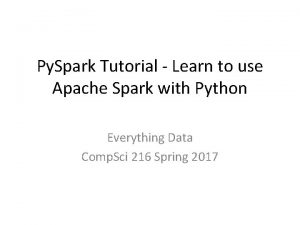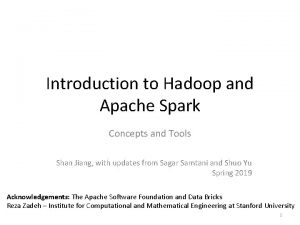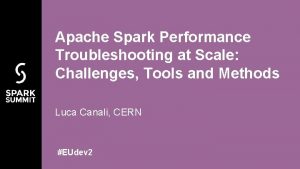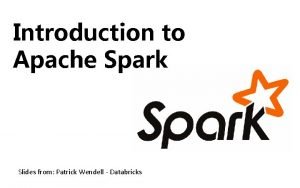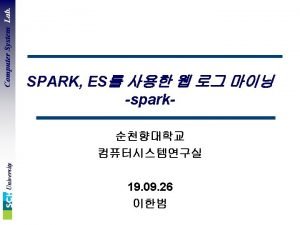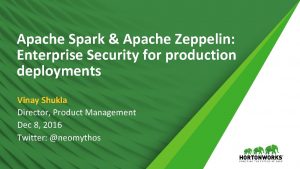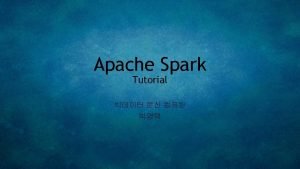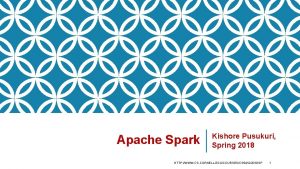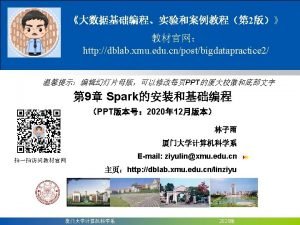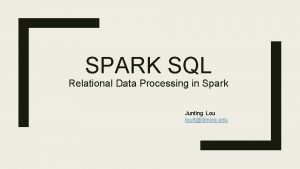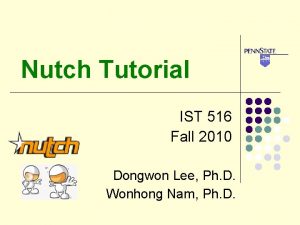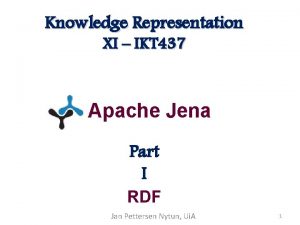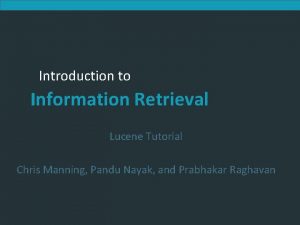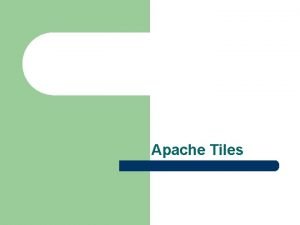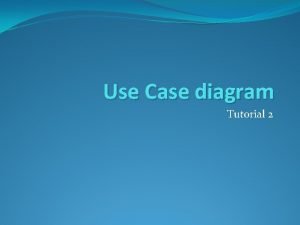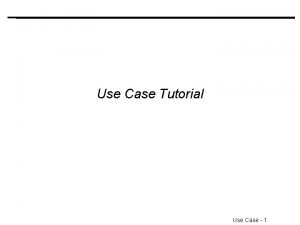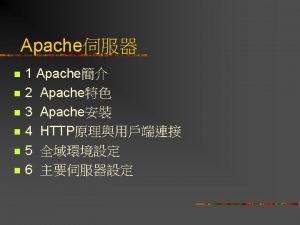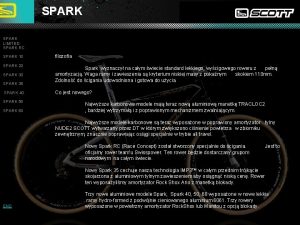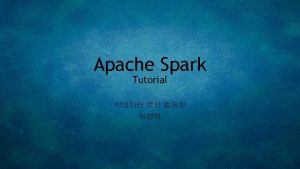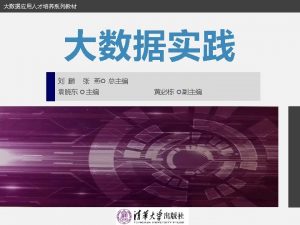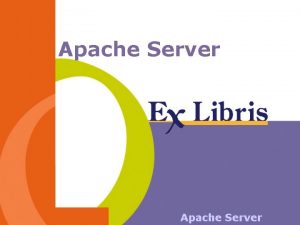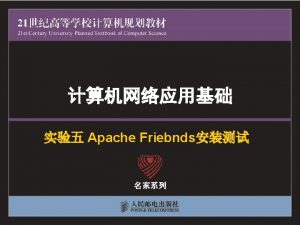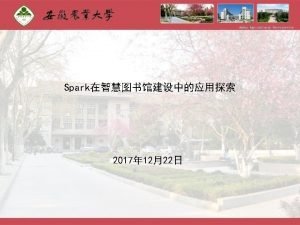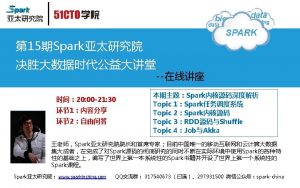Py Spark Tutorial Learn to use Apache Spark








![map() and flat. Map() examples • lines. take(2) [‘#good d#ay #’, ‘#good #weather’] • map() and flat. Map() examples • lines. take(2) [‘#good d#ay #’, ‘#good #weather’] •](https://slidetodoc.com/presentation_image/278d18990040fb1de1f0435899ddeb68/image-9.jpg)








- Slides: 17

Py. Spark Tutorial - Learn to use Apache Spark with Python Everything Data Comp. Sci 216 Spring 2017

Outline • • Apache Spark and Spark. Context Spark Resilient Distributed Datasets (RDD) Transformation and Actions in Spark RDD Partitions

Apache Spark and Py. Spark • Apache Spark is written in Scala programming language that compiles the program code into byte code for the JVM for spark big data processing. • The open source community has developed a wonderful utility for spark python big data processing known as Py. Spark.

Spark. Context • Spark. Context is the object that manages the connection to the clusters in Spark and coordinates running processes on the clusters themselves. Spark. Context connects to cluster managers, which manage the actual executors that run the specific computations • spark = Spark. Context("local", "Python. Hash. Tag")

Resilient Distributed Datasets (RDD) • An RDD is Spark's representation of a dataset that is distributed across the RAM, or memory, of lots of machines. • An RDD object is essentially a collection of elements that you can use to hold lists of tuples, dictionaries, lists, etc. • Lazy Evaluation : the ability to lazily evaluate code, postponing running a calculation until absolutely necessary. • num. Partitions = 3 lines = spark. text. File(“hw 10/example. txt”, num. Partitions) lines. take(5)

Transformation and Actions in Spark • RDDs have actions, which return values, and transformations, which return pointers to new RDDs. • RDDs’ value is only updated once that RDD is computed as part of an action

Transformation and Actions Spark Transformations map() flat. Map() filter() map. Partitions() Spark Actions reduce. By. Key() collect() count() take. Ordered()

map() and flat. Map() • map() transformation applies changes on each line of the RDD and returns the transformed RDD as iterable of iterables i. e. each line is equivalent to a iterable and the entire RDD is itself a list • flat. Map() This transformation apply changes to each line same as map but the return is not a iterable of iterables but it is only an iterable holding entire RDD contents.
![map and flat Map examples lines take2 good day good weather map() and flat. Map() examples • lines. take(2) [‘#good d#ay #’, ‘#good #weather’] •](https://slidetodoc.com/presentation_image/278d18990040fb1de1f0435899ddeb68/image-9.jpg)
map() and flat. Map() examples • lines. take(2) [‘#good d#ay #’, ‘#good #weather’] • words = lines. map(lambda lines: lines. split(' ')) [[‘#good’, ‘d#ay’, ’#’], [‘#good’, ‘#weather’]] • words = lines. flat. Map(lambda lines: lines. split(' ')) [‘#good’, ‘d#ay’, ‘#good’, ‘#weather’] Instead of using an anonymous function (with the lambda keyword in Python), we can also use named function anonymous function is easier for simple use

Filter() • Filter() transformation is used to reduce the old RDD based on some condition. • How to filter out hashtags from words hashtags = words. filter(lambda word: "#" in word) [‘#good’, ‘d#ay’, ‘#good’, ‘#weather’] which is wrong. hashtags = words. filter(lambda word: word. startswith("#")). filter(lambda word: word != "#") which is a caution point in this hw. [‘#good’, ‘#weather’]

reduce. By. Key() • reduce. By. Key(f) combines tuples with the same key using the function we specify f. hashtags. Num = hashtags. map(lambda word: (word, 1)) [(‘#good’, 1), (‘#weather’, 1)] hashtags. Count = hashtags. Num. reduce. By. Key(lambda a, b: a+b) or hashtags. Count = hashtags. Num. reduce. By. Key(add) [(‘#good’, 2), (‘#weather’, 1)]

RDD Partitions • Map and Reduce operations can be effectively applied in parallel in apache spark by dividing the data into multiple partitions. • A copy of each partition within an RDD is distributed across several workers running on different nodes of a cluster so that in case of failure of a single worker the RDD still remains available.

map. Partitions() • map. Partitions(func) transformation is similar to map(), but runs separately on each partition (block) of the RDD, so func must be of type Iterator<T> => Iterator<U> when running on an RDD of type T.

Example-1: Sum Each Partition

Example-2: Find Minimum and Maximum


optional reading • Resilient Distributed Datasets: A Fault. Tolerant Abstraction for In-Memory Cluster Computing Reference • https: //www. dezyre. com/apache-spark-tutorial/pyspark-tutorial • http: //www. kdnuggets. com/2015/11/introduction-sparkpython. html • https: //github. com/mahmoudparsian/pysparktutorial/blob/master/tutorial/map-partitions/README. md
 Apache pyspark tutorial
Apache pyspark tutorial Apache spark concepts
Apache spark concepts Apache spark challenges
Apache spark challenges Pyspark sentiment analysis
Pyspark sentiment analysis Apache spark presentation
Apache spark presentation Zeppelin university
Zeppelin university Zeppelin ldap
Zeppelin ldap Spark context
Spark context Apache spark vs spring
Apache spark vs spring Introduction to apache spark
Introduction to apache spark Spark sql: relational data processing in spark
Spark sql: relational data processing in spark Kinesthetic learner
Kinesthetic learner Nutch tutorial
Nutch tutorial Jena eclipse
Jena eclipse Apache lucene tutorial
Apache lucene tutorial Apache tiles
Apache tiles Use case tutorial
Use case tutorial Use cases tutorial
Use cases tutorial
